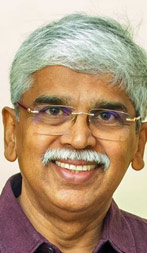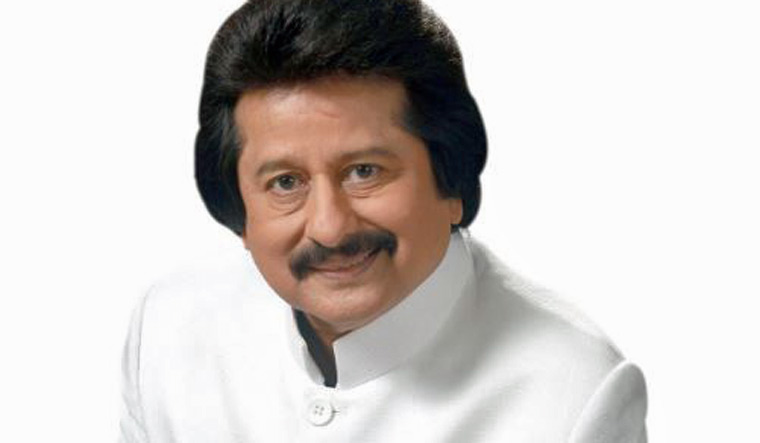When 'Mughal-e Azam' was released in 1960, Pankaj Udhas was a nine-year-old from Jetpur in Rajasthan learning basics in Tabla from his father Keshubhai Udhas. Music composer Noushad had Mohammed Rafi, Lata Mangeshkar, Shamshed Begum and maestro of the Kasur-Patiala gharana Ustad Bade Gulam Ali Khan to sing for Prince Salim, Anarkali and Mian Tanesen in the film. All songs were to praise the eternity of love ('Ae Mohabbat Zindabad'), and Pankaj Udhas can be considered as an offshoot of a filmy Mughal darbar, a blend of Rafi and Ustad Bade Ghulam Ali Khan. He is well-travelled in the route of Ustad's 'Prem Jogan Ban Ke' but with the characteristics of a Mohammed Rafi vocal cord. 'Aahat' in Urdu means the sound of someone's soft arrival. In 1980, Gazal lovers of the sub-continent heard a soft but predictive footstep of a future-trendsetter when the music album 'Aahat' was released. 'Ye Alag Baat Hein' was Pankaj Udhas's first song from the album.
Pankaj Udhas was 29 years old then. All established ghazal singers of that time were at least a decade older than him, whether it was Ghulam Ali, or Jagjit Singh or Iqbal Bano, Chitra Singh or Bhupinder Singh. Farida Khanum was 45 years old at the time. Talat Aziz was the only ghazal singer who was younger than Udhas by five years. Pankaj Udhas with an unusual but spectacular speed came to the centre stage of ghazal singing and one of the main reasons was the Anand Bakshi penned song composed by Lakshmikant and Pyarelal 'Chithi Aayi Hai, Aayi Hai, Chithi Aayi Hai' for Mahesh Bhatt's film 'Naam'. The film song had all the traits of a ghazal, whether its structure or content, anatomical frames like Matla'a, Radif or Qaafiyaa. The song paved an embellished way for its singer for time to come. The song had the pain of separation, an aroma of fondness, and the language of intense expression, which all Begum Akthar had in her wounded voice in abundance. But, she remains a nonpareil phenomenon in ghazal singing and ghazals by most of the established singers born in the 1940s or later could not import the core of Thumri tradition into the singing style as the eternal singer from Awadh could accomplish. If I quote a music-loving friend's candid remark on Akthari Bai Faizabadi here, 'a chocolate is quite different from a sugary candy'.

Pankaj Udhas had lessons in Hindustani classical vocalism from Ustad Ghulam Qadir Khan of the Mewati gharana, son of Ustad Wahid Khan. Thumri, ghazal and earlier counterparts like tappa all have played a major role in South Asian music, but unlike tappa or thumri there are no claimants for ghazals for a possible ancient root in Sanskrit. 'ghazal is a unique product of a cultural moment marked by unprecedented socio-historical features', as musicologist Peter Manuel said. There are many references to prove that this music genre evolved through an Indo-Persian cultural amalgam. Pankaj Udhas, like all his contemporaries in ghazal singing, carried forward the spirit of the same aesthetic vigour produced by the coexistence of varying cultures and beliefs.
In a ghazal, the lyrics always address a person, often a beloved. Pankaj Udhas tenderly established that one-to-one relationship with a listener, by intertwining his songs with sorrows or pleasures of every individual. When he sang ‘warna main kuch bhi hoon, ehsaan faramosh nahi’, the listener thought he was comforting her or him by saying, ‘I may have forgotten everything but I remember your affection for me’. Ghazals represent a universal genre of song for love. At the time of his execution in 1936, Federico García Lorca, a Spanish poet, was preparing for his last compilation of poems, which were gacelas, meaning ghazals. In ‘gacela of unforeseen love’ Lorca wrote,
‘Between plaster and jasmines,
your glance was a pale branch of seeds.
I sought in my heart to give you
the ivory letters that say "siempre" '
Siempre in Spanish means ‘always’, and we, music lovers of the sub-continent will remember you, Pankaj Udhas, always.



